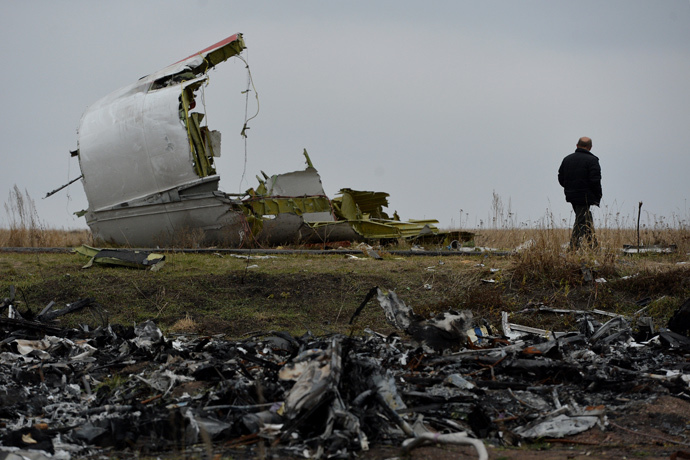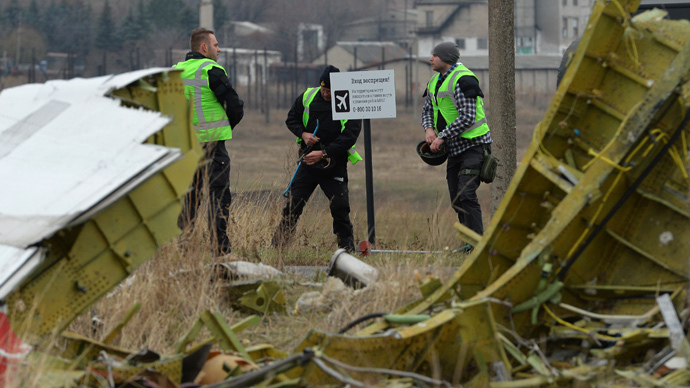New radar data indicating that military aircraft were in the air near Malaysia Airlines flight MH17 when it crashed in eastern Ukraine on July 17 has been released by a Russian air safety consultancy.
The consultancy provided a snapshot representing the readings taken by a radar station located in Russia’s Rostov, near the Ukrainian border, shortly before and about 20 minutes after the MH17 crash.
According to Sergey Melnichenko, CEO of Aviation Safety consultancy, there were one or two warplanes in the air close to the Malaysian airliner. The data casts doubt on the version of the tragedy favored by Western nations, which claims the plane was shot down from the ground by rebel forces with a sophisticated surface-to-air missile.
The data “came from an air traffic control center in Rostov,” Melnichenko told Moskovsky Komsomolets newspaper, declining to reveal which one and whether it was civilian or military. He assured that “we have full trust in the sources, which helped us make it available to the public.”
“The data clearly shows that at the moment of the crash and after it there were planes moving north of the Boeing course. Most likely, they were military, because the spots are very close to each other. The conclusion is that there were either one or two aircraft there,” Melnichenko told the daily.

Another indication that the planes in question were military aircraft is the fact that they didn’t respond to being scanned, Melnichenko said. Civilian planes always reply to signals from radar, while military aircraft are “usually unequipped with transmitter-responders or the pilots turn them off during combat flights,” he explained.
With the rebel forces possessing no air force of their own, Russia and Ukraine are the most logical parties to send warplanes to that area, the expert said. But it would have been impossible for a Russian warplane to make it over the border without being detected by Ukrainian and NATO radars.
“There would’ve been reaction on something like that long ago – from NATO and Ukraine. But there was no reaction because there was nothing to react to,” he explained.

Several days after the MH17 crash, the Russian Defense Ministry released evidence that it detected a Ukrainian fighter jet near the Boeing at the time of the catastrophe. Kiev denied deploying any jets on that day, but it had been routinely using aviation to deliver airstrikes at rebel positions.
READ MORE: Ukrainian Su-25 fighter detected in close approach to MH17 before crash - Moscow
According to Melnichenko, the new data is consistent with that published by the military.
“Our data is somewhat more precise...they didn’t present the airplane’s flight paths as clearly. But maybe they did it intentionally, I don’t know,” he said.
The expert added that the presence of military planes north of the Boeing would put them in a position to the left of the plane. Some photos from the crash site showed damage to the cockpit’s left side, consistent with a scenario of an attack by those planes.
READ MORE: MH17 might have been shot down from air – chief Dutch investigator
All 298 people aboard Malaysia Airlines flight MH17 were killed when the airliner crashed on July 17. The plane was downed over the warzone in Ukraine’s Donetsk region, where Kiev authorities imposed after the February coup launched a military crackdown on rebels rejecting the change of power.
Both sides involved in the conflict have accused each other of bringing down the aircraft. Kiev and its Western sponsors claim it was shot by a BUK defense missile system brought from Russia, and hold Moscow accountable for the tragedy. No evidence has ever been presented, except for questionable photos floating online which claim to show the system.
In late October, the chief investigator with the Dutch National Prosecutors' Office, Fred Westerbeke, told Der Spiegel magazine that his team is open to the theory that another plane shot down the Malaysian airliner.
According to its website, Aviation Safety consultancy and analysis agency provides information, advice, and analytical services in the field of aviation safety for the members of the Commonwealth of Independent States (CIS), a collective of former Soviet republics.

